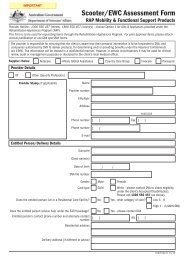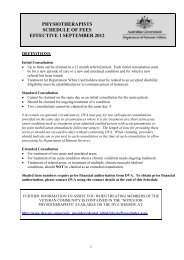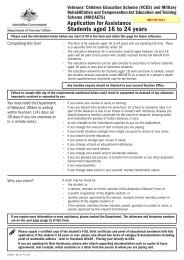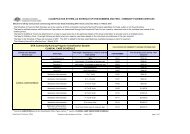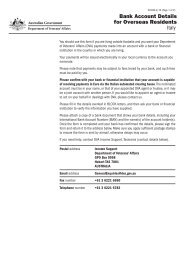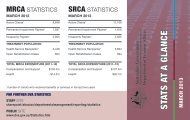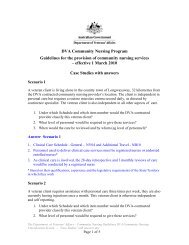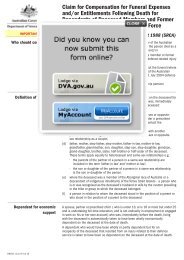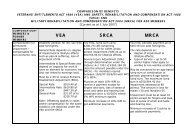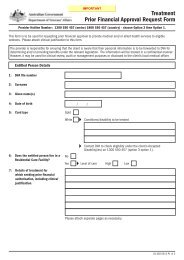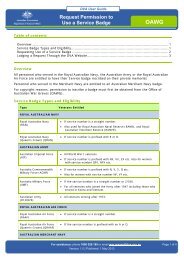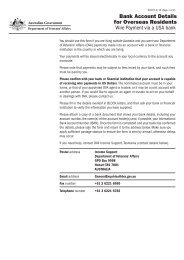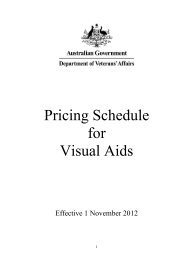Coordinated Veterans' Care Program - A Guide for General Practice
Coordinated Veterans' Care Program - A Guide for General Practice
Coordinated Veterans' Care Program - A Guide for General Practice
Create successful ePaper yourself
Turn your PDF publications into a flip-book with our unique Google optimized e-Paper software.
ISBN 978-1-877007-65-5<br />
P02168 May 2011<br />
Revised July 2011<br />
Revised August 2012<br />
© Commonwealth of Australia 2011<br />
This work is copyright. Apart from any use as permitted under the Copyright Act 1968, no part may be<br />
reproduced by any process without prior written permission from the Department of Veterans’ Affairs.<br />
Requests and enquiries concerning reproduction and rights should be addressed to the Department of<br />
Veterans’ Affairs, GPO Box 9998, Canberra ACT 2601 or emailed to publications@dva.gov.au.<br />
Published by the Department of Veterans’ Affairs, Canberra, 2011.
Contents<br />
Overview ���������������������������������������������������������������������������������������������������������2<br />
Prepare <strong>for</strong> the CVC <strong>Program</strong> ������������������������������������������������������������������������8<br />
1� Appoint a Nurse Coordinator������������������������������������������������������������������������������������ 9<br />
2� Prepare your practice <strong>for</strong> the CVC <strong>Program</strong> ������������������������������������������������������������ 9<br />
Enrol participants in the program ����������������������������������������������������������������12<br />
3� Identify potential participants ������������������������������������������������������������������������������� 13<br />
4� Assess eligibility <strong>for</strong> the program �������������������������������������������������������������������������� 14<br />
5� Gain the participant’s consent �������������������������������������������������������������������������������� 15<br />
6� Conduct a needs assessment ������������������������������������������������������������������������������� 16<br />
7� Prepare a <strong>Care</strong> Plan ���������������������������������������������������������������������������������������������� 16<br />
8� Finalise the <strong>Care</strong> Plan �������������������������������������������������������������������������������������������� 17<br />
9� Consider the need <strong>for</strong> social assistance ��������������������������������������������������������������� 18<br />
Provide ongoing care ������������������������������������������������������������������������������������22<br />
10� Coordinate treatment services as per the <strong>Care</strong> Plan ������������������������������������������ 23<br />
11� Regularly review, update and renew the <strong>Care</strong> Plan ��������������������������������������������� 25<br />
Other �������������������������������������������������������������������������������������������������������������28<br />
Summary of roles and responsibilities ���������������������������������������������������������������������� 28<br />
Payments to general practitioners ���������������������������������������������������������������������������� 29<br />
Further in<strong>for</strong>mation and resources ��������������������������������������������������������������������������� 32<br />
Page 1
Page 2
Overview<br />
Overview
Overview<br />
About the CVC <strong>Program</strong><br />
The Department of Veterans’ Affairs (DVA) new <strong>Coordinated</strong> Veterans’ <strong>Care</strong> <strong>Program</strong> (known as the<br />
CVC <strong>Program</strong>) commenced on 1 May 2011. The CVC <strong>Program</strong>:<br />
● uses a proactive approach to improve the management of participants’ chronic diseases<br />
and quality of care<br />
● involves a care team of a general practitioner (GP) plus a nurse coordinator who work with<br />
the participant (and their carer if applicable) to manage their ongoing care<br />
● provides new payments to GPs <strong>for</strong> initial and ongoing care.<br />
GPs who decide to be involved in the CVC <strong>Program</strong> are required to:<br />
● prepare <strong>for</strong> the program<br />
Eligibility<br />
● enrol participants in the program<br />
● provide ongoing care.<br />
The program is aimed at veterans, war widows, war widowers and dependants who are Gold Card<br />
holders and are at risk of being admitted or readmitted to hospital.<br />
GPs can enrol participants in the program if they:<br />
● pass an eligibility assessment<br />
● give their in<strong>for</strong>med consent to be involved in the program.<br />
Payments <strong>for</strong> GPs<br />
By participating in the program, GPs can claim the following payments through existing payment<br />
arrangements with Medicare Australia:<br />
● Initial Incentive Payment <strong>for</strong> enrolling a participant in the program<br />
● Quarterly <strong>Care</strong> Payments <strong>for</strong> ongoing care.<br />
Initial Incentive Quarterly <strong>Care</strong><br />
Payment* Payments*<br />
$ Item # $ Item #<br />
Total<br />
year 1<br />
Total<br />
year 2<br />
onward<br />
GP with practice nurse $408.00 UP01 $425.85 UP03 $2111.40 $1703.40<br />
GP without<br />
practice nurse<br />
* Fees effective 1 November 2011 to 31 October 2012.<br />
Legislation<br />
Page 2<br />
$255.00 UP02 $191.25 UP04 $1020.00 $765.00<br />
The CVC <strong>Program</strong> is administered under the Treatment Principles – <strong>Coordinated</strong> Veterans’ <strong>Care</strong><br />
<strong>Program</strong>, the Notes <strong>for</strong> Providers <strong>for</strong> the Veterans’ Entitlements Act 1986, and the Military Rehabilitation<br />
and Compensation Act 2004.
CVC <strong>Program</strong> Model of <strong>Care</strong><br />
The Model of <strong>Care</strong> <strong>for</strong> the CVC <strong>Program</strong> is based on the core team, which includes the veteran, the<br />
veteran’s carer (if applicable), the GP and the nurse coordinator, who is either a practice nurse,<br />
Aboriginal health worker or community nurse�<br />
The team uses care planning, coordination and review as the tool to focus on better management and<br />
self management of the participant’s health and to incorporate the multidisciplinary team�<br />
The sharing of health in<strong>for</strong>mation is a key feature of the CVC <strong>Program</strong>� The future availability of<br />
electronic health records and electronic communication will greatly assist the CVC <strong>Program</strong> in the<br />
sharing of health in<strong>for</strong>mation amongst all providers of health care <strong>for</strong> CVC participants� As these<br />
capabilities develop, DVA expects that electronic health records and communication will be a key part<br />
of the CVC Model of <strong>Care</strong>�<br />
Regular communication, empowerment and coaching are key to the success of the team�<br />
The care planning cycle is continuous and most participants going on the program will stay on<br />
the program�<br />
Page 3
Benefits <strong>for</strong> participants<br />
Page 4<br />
As a result of the program, participants will become:<br />
● healthier, with less need to be admitted to hospital<br />
● more educated and empowered to self manage their conditions�<br />
Benefits <strong>for</strong> health professionals<br />
As a result of the program, health professionals will benefit in numerous ways:<br />
● GPs receive recognition and compensation, including <strong>for</strong> non face-to-face time spent<br />
in providing comprehensive care to eligible participants<br />
● help improve the quality of care of participants<br />
● enhanced opportunity <strong>for</strong> nurses to work in partnership with the GP<br />
● efficient alignment of nursing roles with nursing skills<br />
● receive training and resources <strong>for</strong> chronic disease management�<br />
Key roles and stages<br />
GPs play a lead role and are required to commit sufficient time and resources to the program�<br />
The nurse coordinator (NC) can be one of the following:<br />
● practice nurse (PN) – this is either a registered nurse or enrolled nurse, and<br />
can include a nurse practitioner<br />
● Aboriginal health worker (AHW)<br />
● community nurse from a DVA contracted community nursing provider (CN)�<br />
The GP and nurse coordinator have different roles in the three stages of the CVC <strong>Program</strong>�
Prepare <strong>for</strong> the CVC <strong>Program</strong><br />
Action Role<br />
1� Appoint a NC, ie PN, AHW or CN� GP<br />
2� Prepare your practice <strong>for</strong> the CVC <strong>Program</strong>� GP<br />
Enrol participant in the program<br />
Action Role<br />
3� Identify potential participants� DVA/GP<br />
4� Assess their eligibility <strong>for</strong> the program� GP<br />
5� Gain the participant’s in<strong>for</strong>med consent� GP<br />
6� Conduct a needs assessment� GP/PN<br />
7� Prepare a <strong>Care</strong> Plan� GP/PN<br />
8� Finalise the <strong>Care</strong> Plan� GP<br />
9� Consider the need <strong>for</strong> social assistance� GP<br />
Provide ongoing care<br />
Action Role<br />
10� Coordinate treatment services as per the <strong>Care</strong> Plan� GP/NC<br />
11� Regularly review, update and renew the <strong>Care</strong> Plan� GP/NC<br />
Training & Resources in<br />
Chronic Disease Management<br />
DVA has contracted the Australian Medicare Local Alliance to provide<br />
free comprehensive training and resources in chronic disease management<br />
<strong>for</strong> GPs, practice and community nurses participating in the CVC <strong>Program</strong>�<br />
This training is available on-line and comprises four modules:<br />
Module One – <strong>Coordinated</strong> Veterans’ <strong>Care</strong>: Is your service ready?<br />
Module Two – <strong>Care</strong> Planning and Coordination<br />
Module Three – Managing <strong>Care</strong> Plans with disease-specific elements, and<br />
Module Four – Veterans’ social isolation, mental health and wellbeing�<br />
To access the training and resources material, visit www�cvcprogram�net�au<br />
Page 5
Page 6
Prepare<br />
Prepare
Prepare <strong>for</strong> the CVC <strong>Program</strong><br />
The first stage <strong>for</strong> general practitioners (GPs) involved in the <strong>Coordinated</strong> Veterans’ <strong>Care</strong> (CVC)<br />
<strong>Program</strong> is preparation which involves:<br />
● appointing a nurse coordinator<br />
Page 8<br />
● preparing your practice <strong>for</strong> the CVC <strong>Program</strong>.
STEPS<br />
1� Appoint a Nurse Coordinator<br />
Overview<br />
In managing the CVC <strong>Program</strong>, one of your first actions is to appoint a nurse coordinator, whose role is<br />
to coordinate the <strong>Care</strong> Plan�<br />
The nurse coordinator is either:<br />
● a practice nurse (PN)<br />
● an Aboriginal health worker (AHW)<br />
● a community nurse from a DVA contracted community nursing provider�<br />
Tip: For in<strong>for</strong>mation on appointing a community nurse as a nurse coordinator, refer to page 32�<br />
Qualifications<br />
A registered nurse is preferred as the nurse coordinator�<br />
However, where there is no registered nurse:<br />
● An enrolled nurse (EN) or, if appropriate, an Aboriginal health worker (AHW), may be<br />
appointed as the nurse coordinator�<br />
● The EN or AHW is expected to undertake CVC training as follows:<br />
| complete the first CVC training module within a reasonable period of time of<br />
commencing care coordination<br />
| complete additional training modules as these are released�<br />
● The GP will play a closer clinical role in care coordination with an EN or AHW�<br />
2� Prepare your practice <strong>for</strong> the CVC <strong>Program</strong><br />
Set-up and procedures<br />
While many practices have already shifted towards proactive, planned, multidisciplinary care, you may<br />
need to make some changes to your practice set-up and procedures prior to enrolling participants in<br />
the CVC <strong>Program</strong>�<br />
Preparation checklist<br />
The following checklist will help you to prepare your practice <strong>for</strong> the CVC <strong>Program</strong>:<br />
Check Action Role<br />
Do all members of the care team understand the basic requirements<br />
and roles and are they committed to supporting the program?<br />
Have you appointed a nurse coordinator? GP<br />
If a PN or AHW is the nurse coordinator, have you set up:<br />
● a reminder system to prompt the PN to call/visit/make<br />
appointments <strong>for</strong> CVC patients GP<br />
● a discrete space <strong>for</strong> the PN to coordinate care in privacy<br />
● home visit capability <strong>for</strong> the PN to visit CVC patients who live<br />
within a reasonable time and distance?<br />
GP<br />
Page 9
Page 8
Enrol<br />
Enrol
Enrol participants in the program<br />
The second stage of the <strong>Coordinated</strong> Veterans’ <strong>Care</strong> (CVC) <strong>Program</strong> is <strong>for</strong> general practitioners (GP)<br />
to enrol participants in the program, ie:<br />
● Department of Veterans’ Affairs (DVA) and GPs identify potential participants<br />
Page 12<br />
● assess eligibility <strong>for</strong> the program<br />
● gain the participant’s consent<br />
● conduct a needs assessment<br />
● prepare a <strong>Care</strong> Plan<br />
● finalise the <strong>Care</strong> Plan<br />
● consider the need <strong>for</strong> social assistance.<br />
There is no enrolment <strong>for</strong>m to complete and return to DVA. When all steps are completed,<br />
the GP records the enrolment and consent on the patient's record. The GP can now claim the Initial<br />
Incentive Payment and this will automatically in<strong>for</strong>m DVA that the patient is now a participant of the<br />
CVC <strong>Program</strong>.
STEPS<br />
3� Identify potential participants<br />
Who is the program targeted at?<br />
The CVC <strong>Program</strong> targets veterans, war widows, war widowers and dependants who are Gold Card<br />
holders and are at risk of being admitted or readmitted to hospital�<br />
The program is primarily focussed on Gold Card holders with the following chronic conditions:<br />
● congestive heart failure<br />
● coronary artery disease<br />
● pneumonia<br />
● chronic obstructive pulmonary disease<br />
● diabetes�<br />
Who identifies participants?<br />
Individuals may be identified as potential participants <strong>for</strong> the program in various ways� However,<br />
the key means of identification of participants is through DVA with the assistance of Bupa Health<br />
Dialog (BHD)�<br />
DVA with BHD<br />
Patient or care<br />
provider<br />
GP<br />
Initial screening<br />
DVA/BHD identifies potential participants as follows:<br />
● uses predictive modelling to analyse the health care data of<br />
Gold Card holders<br />
● sends letters to the most likely participants, and their usual<br />
GP, and recommends they seek an assessment�<br />
A patient or care provider may identify a potential participant as<br />
follows:<br />
● a patient may ask to participate in the CVC <strong>Program</strong><br />
● their care provider, such as a carer, specialist, allied health<br />
worker, hospital discharge planner or community nurse, may<br />
recommend they arrange an appointment with their GP <strong>for</strong><br />
an assessment <strong>for</strong> the CVC <strong>Program</strong>�<br />
A GP may identify one of their patients as a potential participant�<br />
When a GP receives a letter from DVA, identifying a patient as a potential participant or a request <strong>for</strong><br />
an assessment appointment, either the GP or the practice nurse (PN) should:<br />
● check the patient’s medical record to ensure there are no obvious disqualifying factors<br />
(e�g� terminal condition or lives in a residential aged care facility – refer to the Eligibility<br />
Checklist on page 14)<br />
● contact the patient and explain the CVC <strong>Program</strong> to them<br />
● make an assessment appointment if the patient is interested in the program�<br />
Note: The CVC items are in addition to all existing LMO Fee Schedule items� The assessment<br />
appointment is billed as a separate consultation�<br />
Page 13
STEPS<br />
4� Assess eligibility <strong>for</strong> the program<br />
Eligibility Checklist<br />
Page 14<br />
During the assessment appointment, the GP assesses the person to determine whether they are eligible<br />
<strong>for</strong> the CVC <strong>Program</strong>� The following set of eligibility criteria and disqualifying factors are used to assess a<br />
potential participant’s eligibility <strong>for</strong> the program�<br />
A� MUST apply<br />
Part A: ALL of the following eligibility criteria must apply to a potential participant:<br />
B� Must NOT apply<br />
Are they a current holder of a DVA Gold Card?<br />
Do they currently live in the community (not in residential aged care)?<br />
Have they been diagnosed with one or more chronic diseases or conditions that have<br />
resulted, or could reasonably result, in frequent hospitalisation?<br />
Do they have complex care needs, being one or more of the following:<br />
● multiple comorbidities that complicate the treatment<br />
● unstable condition with a high risk of acute exacerbation<br />
● the condition is contributed to by frailty, age and/or social<br />
isolation factors<br />
● limitations in self management and monitoring?<br />
Do they require a treatment regimen that involves one or more of the following<br />
complexities of ongoing care:<br />
● multiple care providers<br />
● complex medication regimen<br />
● frequent monitoring and review<br />
● support with self management and self monitoring?<br />
Have they given their in<strong>for</strong>med consent to go on the program?<br />
Part B: To the best of the GP’s knowledge, none of the following disqualifying factors can apply to the<br />
potential participant:<br />
Are they currently a resident of a residential aged care facility?<br />
Have they been diagnosed with a condition that, in your opinion, would be likely to<br />
be terminal within 12 months? (Note: This applies only <strong>for</strong> initial admission; not<br />
where the diagnosis occurs after admission to the program�)<br />
Are they a participant in any of the following Commonwealth Department of<br />
Health and Ageing programs: Extended Aged <strong>Care</strong> at Home, Diabetes <strong>Care</strong><br />
Project, Transition <strong>Care</strong>, or any other similar Department of Health and Ageing<br />
program?<br />
If ALL answers <strong>for</strong> Part A are Yes and Part B are No, they can be enrolled in the program�
STEPS<br />
5� Gain the participant’s consent<br />
Separate consent<br />
In order to enrol a participant in the CVC <strong>Program</strong>, the GP needs to gain their in<strong>for</strong>med consent to<br />
participating in the program, the use of a nurse coordinator and the sharing of their relevant health<br />
and medical in<strong>for</strong>mation�<br />
Note: This consent is in addition to the standard consents of Gold Card holders�<br />
Explain consent<br />
In order to gain the participant’s in<strong>for</strong>med consent, the GP explains the following:<br />
● What it will mean <strong>for</strong> them to be on the CVC <strong>Program</strong>�<br />
● What they are required to consent to:<br />
| the sharing of their relevant health and medical in<strong>for</strong>mation<br />
| the involvement of the nominated nurse coordinator<br />
| the <strong>Care</strong> Plan that will be prepared as part of the enrolment in the CVC <strong>Program</strong>�<br />
● Their relevant health and medical in<strong>for</strong>mation will be shared with their health care<br />
providers as follows:<br />
| health care providers include specialists, pharmacists, allied health, community<br />
nurses, hospital discharge planners, assessors/providers of social assistance and<br />
nominated carers<br />
| regular reports on all DVA paid treatments and medicines will be provided to the GP<br />
| this will allow a shared holistic understanding of their condition<br />
| privacy principles and legislation will be observed by all recipients of the in<strong>for</strong>mation�<br />
Tip: Refer to the suggested script on page 32 <strong>for</strong> obtaining their in<strong>for</strong>med consent�<br />
Ask <strong>for</strong> their consent<br />
Once the GP has explained what they will be consenting to, ask <strong>for</strong> their consent to:<br />
● participate in the program<br />
● the use of a nurse coordinator<br />
● the sharing of their personal in<strong>for</strong>mation, including relevant health and medical in<strong>for</strong>mation<br />
and data, as outlined�<br />
Explain that they will also be asked to consent to the <strong>Care</strong> Plan that will be prepared as part of their<br />
enrolment in the program�<br />
Substitute consent<br />
If the person is unable to provide in<strong>for</strong>med consent, a person who is legally authorised to give<br />
substitute consent to treatment under state law (e�g� Public Trustee, guardian, holder of an<br />
appropriate Special Power of Attorney) may consent on their behalf�<br />
Note: If consent is not obtained, they cannot be enrolled on the program�<br />
Once in<strong>for</strong>med consent is obtained, the GP proceeds to the next steps <strong>for</strong> enrolling a participant in<br />
the program� A participant is not considered to be enrolled until all steps have been completed�<br />
Page 15
STEPS<br />
6� Conduct a needs assessment<br />
Conduct a needs assessment<br />
Page 16<br />
The GP or PN conducts a comprehensive needs assessment of the participant�<br />
Where the PN is the nurse coordinator, it is recommended that they conduct the needs assessment –<br />
preferably in the patient’s home�<br />
It is strongly recommended that the GP or PN use the questionnaires available at the CVC Training and<br />
Resources site at www�cvcprogram�net�au to assist with assessing a person’s current self management of<br />
their health, a person's current mental health and a person’s management of their current lifestyle� Refer<br />
to page 32 <strong>for</strong> more details�<br />
7� Prepare a <strong>Care</strong> Plan<br />
Prepare a <strong>Care</strong> Plan<br />
Once a comprehensive needs assessment has been conducted, the GP or PN prepares a comprehensive<br />
<strong>Care</strong> Plan (or updates an existing plan)� The GP must be involved in the finalisation of the <strong>Care</strong> Plan�<br />
The <strong>Care</strong> Plan is a comprehensive version of a <strong>General</strong> Practitioner Management Plan, which is an existing<br />
LMO Fee Schedule item and is billed as a separate service to the CVC items� The <strong>Care</strong> Plan is tailored to the<br />
participant’s health needs, preferences and priorities�<br />
To allow flexibility <strong>for</strong> GPs, there is no mandated <strong>Care</strong> Plan template� However the checklist below provides<br />
the minimum requirements expected in the <strong>Care</strong> Plan�<br />
<strong>Care</strong> Plan Checklist<br />
The <strong>Care</strong> Plan should contain at least the following in<strong>for</strong>mation:<br />
● a description of all chronic and other health conditions, including:<br />
| current care guide<br />
| targets<br />
| red flags<br />
| background in<strong>for</strong>mation<br />
| current management<br />
| most recent results<br />
● medications list including dose, frequency and known adherence<br />
● allergies and adverse reactions<br />
● self management goals and strategies<br />
● any family and/or carer contact details<br />
● significant medical events and results<br />
● other treatment providers and their contact details<br />
● referrals planned and reasons <strong>for</strong> referral<br />
● devices being used�<br />
Discuss with participant<br />
The GP or PN discusses the <strong>Care</strong> Plan with the participant to ensure that they understand the following:<br />
● goals of the <strong>Care</strong> Plan<br />
● interventions and self management aspects<br />
● methods of monitoring and evaluating the plan<br />
● the need <strong>for</strong> regular monitoring and review�<br />
When this has been done, the participant is asked to give their consent to the <strong>Care</strong> Plan�
STEPS<br />
8� Finalise the <strong>Care</strong> Plan<br />
Key steps<br />
When the participant gives their consent to the <strong>Care</strong> Plan:<br />
● the GP records the decision to enrol them in the program<br />
● the GP records their consent to participate in the program<br />
● the PN or GP provides the participant (and any carer/family as agreed) with a patient<br />
friendly version of the <strong>Care</strong> Plan�<br />
Patient version of <strong>Care</strong> Plan<br />
A patient friendly version of a <strong>Care</strong> Plan should:<br />
● be in large type and use simple language<br />
● remind the participant to take medications, observe dietary restrictions, participate in<br />
appropriate physical activity, monitor physiological parameters such as weight and blood<br />
pressure and to follow-up with other health professionals where required<br />
● provide symptoms and situations where the participant or carer should contact the practice<br />
or an after hours service and provide contact details <strong>for</strong> these�<br />
Enrolment and submitting a claim<br />
At this point in the process:<br />
● The participant has now been enrolled in the CVC <strong>Program</strong>�<br />
● The first quarterly period of care has commenced�<br />
● GPs can now submit a claim <strong>for</strong> the Initial Incentive Payment� Refer to page 29 <strong>for</strong> details�<br />
Note:<br />
● By enrolling a participant in the CVC <strong>Program</strong>, a GP is accepting the clinical leadership and<br />
oversight role <strong>for</strong> the participant�<br />
● If the nurse coordinator is a community nurse, it is very important that the GP submits their<br />
first claim promptly, as a claim by the community nurse will be rejected if the GPs Initial<br />
Incentive Payment has not yet been made�<br />
Page 17
STEPS<br />
9� Consider the need <strong>for</strong> social assistance<br />
Participant’s needs<br />
Page 18<br />
The GP and/or the PN should also consider the participant’s need <strong>for</strong> social assistance and the GP<br />
can provide a referral to a Veterans’ Home <strong>Care</strong> (VHC) assessment agency, where relevant� The most<br />
socially isolated CVC participants will receive social assistance under this program�<br />
What is CVC Social Assistance?<br />
The VHC <strong>Program</strong> has expanded its services to include a CVC Social Assistance service type <strong>for</strong> CVC<br />
participants�<br />
This has been done in recognition of the increasing prevalence of social isolation amongst veterans<br />
and the impact of social isolation on their health�<br />
CVC Social Assistance provides short-term services (up to 12 weeks) to encourage longer term<br />
socialisation� For example, assistance with participating in community activities or courses�<br />
These services focus on building the confidence of participants to promote ownership and motivation<br />
<strong>for</strong> their ongoing social health, with a view to establishing and maintaining long-term benefits,<br />
such as:<br />
● re-entry into community life<br />
● expanding the type and frequency of social contact<br />
● encouraging the veteran to proactively engage with communities of interest�<br />
The aim is to promote social health and independence, rather than dependency�<br />
For more in<strong>for</strong>mation go to: www�dva�gov�au/SocialAssistanceOverview�htm<br />
GP identifies potential participants<br />
When a participant is being enrolled in the CVC <strong>Program</strong> (or any time thereafter), the GP may<br />
determine that they could benefit from CVC Social Assistance�<br />
A GP can refer a CVC participant to a VHC assessment agency <strong>for</strong> a social assistance<br />
assessment, where:<br />
● the participant has a limited or inadequate social support network and could reasonably be<br />
at risk of hospitalisation because of that social situation<br />
● the risk of the participant being hospitalised <strong>for</strong> a chronic condition may be significantly<br />
reduced if they receive social assistance�<br />
The VHC assessment agency will determine whether the CVC participant will be provided with CVC<br />
Social Assistance, as well as the amount and type of service to be provided�<br />
Note: Not all referrals <strong>for</strong> an assessment will result in social assistance being provided�
STEPS<br />
VHC assessment agency<br />
To refer a CVC participant <strong>for</strong> a social assistance assessment:<br />
● call 1300 550 450 to be connected with your local VHC assessment agency<br />
● provide the CVC participant’s contact details and any other relevant in<strong>for</strong>mation�<br />
Note: When referring to a VHC assessment agency it should be made clear that it is a<br />
CVC referral�<br />
An assessment will generally be arranged within a few days of the referral, although this can be<br />
done more quickly if urgent�<br />
Follow-up<br />
The GP and/or the nurse coordinator will follow up on the assessment with the participant and<br />
monitor the services supplied and the effect on the participant’s social isolation�<br />
Page 19
Page 16
Provide<br />
Ongoing<br />
<strong>Care</strong><br />
Provide Ongoing <strong>Care</strong>
Provide ongoing care<br />
Page 22<br />
The third stage <strong>for</strong> the care team involved in the <strong>Coordinated</strong> Veterans’ <strong>Care</strong> (CVC) <strong>Program</strong> is<br />
providing ongoing care, which involves:<br />
● coordinating treatment services as per the <strong>Care</strong> Plan<br />
● regularly reviewing, updating and renewing the <strong>Care</strong> Plan.<br />
During this stage, the care team:<br />
● works with the participant (and their carer if applicable) to manage their ongoing care<br />
● uses a proactive approach to improve the management of participants’ chronic diseases<br />
and quality of care<br />
● supports participants to self manage their conditions.<br />
The care team supports the participant to self manage their conditions on an ongoing basis by<br />
providing them with:<br />
● in<strong>for</strong>mation so that they better understand what will improve their condition and what will<br />
make their condition worse<br />
● motivational counselling to empower them to follow their self management goals, e.g. lose<br />
weight or do more exercise.<br />
Note:<br />
● It is expected that most participants who are enrolled in the program will stay on the<br />
program indefinitely.<br />
● <strong>Care</strong> provided under the CVC <strong>Program</strong> is not a replacement of the continued interaction<br />
between the general practitioner (GP) and the patient. Regular consultations should still<br />
occur as necessary.
STEPS<br />
10� Coordinate treatment services as per the <strong>Care</strong> Plan<br />
Overview<br />
The nurse coordinator is responsible <strong>for</strong> coordinating treatment services <strong>for</strong> each participant based on<br />
their <strong>Care</strong> Plan�<br />
The GP provides regular advice and guidance to the nurse coordinator�<br />
Note: The duties of the nurse coordinator vary slightly, depending on whether they are a practice nurse<br />
(PN), Aboriginal health worker (AHW) or community nurse� This is explained in the following sections�<br />
Coordinate treatment services<br />
All nurse coordinators coordinate treatment services <strong>for</strong> the participant as follows:<br />
● monitor the participant’s progress according to the <strong>Care</strong> Plan<br />
● monitor the participant’s physical and mental condition<br />
● maintain regular contact with the participant – at least monthly<br />
● provide the participant with advice, e�g� medication, health coaching, motivational counselling<br />
● liaise with a participant’s carer and keep them in<strong>for</strong>med of progress and changes to the<br />
<strong>Care</strong> Plan<br />
● make appointments with other care providers, if necessary, and provide a copy of the <strong>Care</strong><br />
Plan to all specialists, allied health practitioners and other care providers (as appropriate<br />
and agreed with the GP)<br />
● monitor the actions of all care providers (e�g� prescriptions, tests, referrals and<br />
recommendations) through feedback from the participant, carer, consultation reports and<br />
calls to other care providers<br />
● liaise with emergency and/or hospital discharge departments<br />
● consider and address ongoing social isolation issues<br />
● provide regular feedback about the participant’s condition to the GP, including advice on their<br />
need <strong>for</strong> social assistance services and alerts where changes occur in their condition<br />
● provide feedback to the GP – at least monthly<br />
● maintain up-to-date records of all monitored actions and coordination activity�<br />
Nurse coordinator – PN or AHW<br />
In addition, where the nurse coordinator is a PN or AHW, the following applies:<br />
● They should review the regular patient reports from Department of Veterans’ Affairs (DVA),<br />
crosscheck with practice records and in<strong>for</strong>mation, and alert the GP to any discrepancies or<br />
deviations from the <strong>Care</strong> Plan�<br />
● Contact with the participant may be by telephone, in rooms or through home visits� However,<br />
where the participant lives within a reasonable distance and time from the practice, at least<br />
one home visit should be conducted per year� Where an initial in-home assessment was not<br />
conducted, at least one home visit should be undertaken within the first month of entering<br />
the program�<br />
Nurse coordinator – community nurse<br />
Where the nurse coordinator is a community nurse, they:<br />
● receive the GP <strong>Care</strong> Plan with the referral<br />
● conduct an in-home assessment of the participant<br />
● <strong>for</strong>ward a copy of the Community Nurse Management Plan to the GP <strong>for</strong> their review<br />
● receive feedback from the GP<br />
● visit the CVC participant at home – at least once every 28 days�<br />
Page 23
STEPS<br />
Role of the GP when nurse coordinator is a community nurse:<br />
Page 24<br />
Where the nurse coordinator is a community nurse, the GP should:<br />
● send a referral <strong>for</strong> the DVA contracted community nursing provider that includes their<br />
preferred method of contact, e�g� telephone/fax/e-mail (secure e-mail only)<br />
● send the <strong>Care</strong> Plan with the referral to the community nursing provider<br />
● regularly receive feedback from the community nurse on the participant’s condition and<br />
progress against the goals – at least monthly<br />
● maintain frequent dialogue with the community nurse<br />
● review the regular patient reports from DVA, crosscheck with practice records and<br />
in<strong>for</strong>mation, and note any discrepancies or deviations from the <strong>Care</strong> Plan�<br />
Note:<br />
● The referral <strong>for</strong> a community nurse is valid <strong>for</strong> 12 months, unless it is withdrawn by the GP<br />
or a disqualifying event occurs, e�g� participant enters a residential aged care facility�<br />
● There can be only one provider of community nursing services to a participant at one time�<br />
If a participant is already receiving community nursing services, the GP withdraws the<br />
existing referral and sends a new referral that covers CVC and other nursing services to<br />
the community nursing provider�<br />
Planned hospital admission<br />
Where appropriate, the GP or nurse coordinator should:<br />
● liaise with the hospital during a planned admission<br />
● follow up with the participant on discharge�<br />
Unplanned hospital admission<br />
On learning of an unplanned admission of a CVC participant to hospital, the GP, PN or community<br />
nurse should contact the hospital and:<br />
● advise that the participant is on the CVC <strong>Program</strong> and has a <strong>Care</strong> Plan<br />
● request to be advised of the discharge date<br />
● request a copy of the discharge papers<br />
● ask to be involved in the discharge planning process (if appropriate)�<br />
One or two days after the participant is discharged from hospital, the GP, PN or community nurse<br />
should contact the participant and/or carer to:<br />
● arrange <strong>for</strong> an appointment with the GP either in the surgery or at home<br />
● review the participant’s condition<br />
● review the <strong>Care</strong> Plan (if appropriate)�
STEPS<br />
11� Regularly review, update and renew the <strong>Care</strong> Plan<br />
Overview<br />
GP<br />
The care team is expected to review treatment services <strong>for</strong> the participant on a regular basis� This<br />
includes the <strong>Care</strong> Plan as follows:<br />
● review / update at least every six months<br />
● renew at least every 12 months�<br />
The GP is expected to do the following:<br />
Nurse coordinator<br />
● decide whether the participant should continue on the program be<strong>for</strong>e the end of a<br />
quarterly period of care<br />
● record the decision to approve a subsequent period of care and discuss the need <strong>for</strong> a<br />
review or renewal of the <strong>Care</strong> Plan with the nurse coordinator<br />
● arrange appointments <strong>for</strong> the participant to attend the practice <strong>for</strong> a review or renewal�<br />
The nurse coordinator is expected to do the following:<br />
● provide regular feedback to the GP where a <strong>Care</strong> Plan needs reviewing<br />
● remind the GP when a quarterly period of care is about to expire<br />
● send new or reviewed <strong>Care</strong> Plans to other care providers (as appropriate and agreed<br />
with GP)�<br />
Page 25
Page 20
Other<br />
Other
Other<br />
Summary of roles and responsibilities<br />
Page 28<br />
The care team – general practitioner (GP), nurse coordinator, participant (and their carer if<br />
applicable) – all work together to manage the participant’s conditions on an ongoing basis.<br />
The nurse coordinator may be either a practice nurse (PN), Aboriginal health worker (AHW)<br />
or a community nurse. The following provides a summary of the key responsibilities <strong>for</strong> each<br />
of these roles:<br />
Participant<br />
● self manages their health care according to their <strong>Care</strong> Plan and in conjunction with the<br />
care team.<br />
<strong>General</strong> practitioner<br />
● provides clinical leadership and oversight role <strong>for</strong> the participant<br />
● assesses eligibility of potential participants <strong>for</strong> the program<br />
● finalises the <strong>Care</strong> Plan<br />
● monitors the overall provision of care and provides regular advice and guidance to nurse<br />
coordinator<br />
● ensures the participant has maximum opportunity to continue on the program.<br />
Nurse coordinator – PN or AHW<br />
● monitors the participant’s progress and coordinates treatment services according to the<br />
<strong>Care</strong> Plan<br />
● liaises with the participant and their carer<br />
● educates and motivates the participant<br />
● liaises with and provides a copy of the <strong>Care</strong> Plan to specialists, allied health practitioners<br />
and other care providers, including emergency and/or hospital discharge departments as<br />
appropriate and agreed by the GP<br />
● provides feedback to the GP on the participant’s condition and progress against their<br />
health goals on a regular basis<br />
● maintains comprehensive clinical records and reminds the GP when a quarterly period of<br />
care is about to expire.<br />
Nurse coordinator – community nurse<br />
● receives the GP <strong>Care</strong> Plan and conducts an in-home assessment of the participant<br />
● prepares a Community Nurse Management Plan (CNMP) and <strong>for</strong>wards a copy to the GP<br />
<strong>for</strong> their review<br />
● liaises with the participant and their carer – visits the participant at home at least once<br />
every 28 days, and educates and motivates the participant<br />
● maintains frequent dialogue with the GP – provides feedback to the GP on the<br />
participant’s condition and progress against the goals in the GP <strong>Care</strong> Plan on a regular<br />
basis (at least monthly)<br />
● provides copy of the GP <strong>Care</strong> Plan (if agreed by GP) to and liaises with specialists, allied<br />
health practitioners and other care providers, including emergency and/or hospital<br />
discharge departments.
Comparing key roles<br />
The diagrams below show how the roles vary, depending on whether the GP uses a PN/AHW or a<br />
community nurse�<br />
GP with PN or AHW<br />
GP with community nurse<br />
GP<br />
Payments to general practitioners<br />
<strong>General</strong><br />
Eligibility Assessment<br />
Comprehensive needs assessment<br />
<strong>Care</strong> Plan prepared and finalised<br />
Patient friendly <strong>Care</strong> Plan<br />
Monitors care coordination<br />
Reviews, updates, renews <strong>Care</strong><br />
Plan<br />
Payments are made to GPs using existing Medicare Australia arrangements�<br />
The payments vary as follows:<br />
● A GP who uses a PN or AHW as the nurse coordinator is paid at the higher rate�<br />
● A GP who either uses a community nurse as the nurse coordinator or does the coordination<br />
themselves will be paid the lesser amount�<br />
Note: See payment table on page 2�<br />
Community Nurse<br />
Receives referral and <strong>Care</strong> Plan<br />
In-house assessment. Prepares<br />
CN/MP<br />
Coordinates care<br />
Monitors participant's condition<br />
Educates<br />
Motivates<br />
Feedback to GP<br />
Page 29
Initial Incentive Payment<br />
Page 30<br />
An Initial Incentive Payment is:<br />
● made to the GP <strong>for</strong> enrolling a person in the program and having done all things necessary<br />
<strong>for</strong> the enrolment<br />
● a one-off payment and only paid once per participant, regardless of a change in provider or<br />
PN, or where a participant ceases to be a participant and later re-enters the program.<br />
Quarterly <strong>Care</strong> Payments<br />
Quarterly <strong>Care</strong> Payments are made to the GP as follows:<br />
In<strong>for</strong>mation<br />
Claims<br />
● <strong>for</strong> quarterly periods of care as part of ongoing clinical care leadership of a participant in<br />
the <strong>Coordinated</strong> Veterans’ <strong>Care</strong> (CVC) <strong>Program</strong><br />
● once they submit a claim upon completion of each quarter (the previous quarter must have<br />
expired be<strong>for</strong>e the commencement of the new quarter).<br />
The payment amounts are indexed annually.<br />
The full fee schedule <strong>for</strong> these items is on the Department of Veterans’ Affairs (DVA) website:<br />
www.dva.gov.au/GPfeeschedule.htm<br />
These payments are in addition to all existing LMO Fee Schedule items <strong>for</strong> consultations, chronic<br />
disease management items, etc.<br />
In claiming any item, a GP is confirming that all steps necessary <strong>for</strong> the enrolment of a participant<br />
or <strong>for</strong> the ongoing coordination of care have been done. DVA may conduct post payment audits to<br />
ensure compliance.<br />
Date of service<br />
With PN<br />
Without PN<br />
The date of service <strong>for</strong> the quarterly period is the first day of the quarterly period.<br />
For example, if the period of care runs from 7 May to 6 August, the date of service is 7 May but the<br />
claim <strong>for</strong> UP03 or UP04 cannot be made until after 6 August.<br />
The following diagram shows payments made to GPs with a practice nurse and without a<br />
practice nurse.<br />
Community nurse<br />
UP01 UP03<br />
Gold card<br />
holder enrolled<br />
Initial Incentive<br />
Payment<br />
3 Months 6 Months 9 Months 12 Months<br />
$408.00 $425.85 $425.85 $425.85 $425.85<br />
$255.00 $191.25 $191.25 $191.25 $191.25<br />
Quarterly <strong>Care</strong><br />
Payment<br />
Quarterly <strong>Care</strong><br />
Payment<br />
UP02 UP04<br />
Quarterly <strong>Care</strong><br />
Payment<br />
Quarterly <strong>Care</strong><br />
Payment<br />
Where the GP does not have a PN and uses a community nurse, the GP is paid the lesser amount<br />
and the DVA contracted community nursing provider is paid <strong>for</strong> the nurse coordination activity.
End of life<br />
Where a participant dies partway through a period of care, the GP is entitled to claim the full amount of<br />
the Quarterly <strong>Care</strong> Payment�<br />
Rules <strong>for</strong> transfer of provider<br />
GP to GP<br />
Although a participant in this program can change providers, multiple claims cannot be made from<br />
different providers in the one claim period�<br />
Rules apply to the transfer of care under this program <strong>for</strong> a patient:<br />
● from one GP to another GP<br />
● from a PN to a DVA contracted community nursing provider<br />
● from a DVA contracted community nursing provider to a PN<br />
● from one DVA contracted community nursing provider to another DVA contracted community<br />
nursing provider�<br />
Where a participant changes GPs after starting the program, the new GP:<br />
● cannot claim the Initial Incentive Payment<br />
● can only claim <strong>for</strong> a Quarterly <strong>Care</strong> Payment where the quarter commenced after the expiry<br />
of the previous GP’s quarterly care period�<br />
PN to community nurse<br />
A change from a PN to a community nurse may occur in the following situations:<br />
● The participant and/or the GP decide that a community nurse is better placed to coordinate<br />
the care� In this case, the GP should make all attempts to complete the current quarterly<br />
period of PN coordinated care be<strong>for</strong>e making the change� This will ensure seamless<br />
transition to the community nurse who can begin coordinating care straight away and can<br />
claim after the first 28 day period has been completed�<br />
● The participant changes GP and the GP does not have a PN or the PN cannot provide the<br />
coordination service�<br />
Community nurse to PN<br />
A change from a community nurse to a PN may occur in the following situations:<br />
● The participant and/or the GP decide that a PN is better placed to coordinate the care, or the<br />
GP previously did not have a PN� In this case, the GP should attempt to align the transition<br />
with the next quarterly care period�<br />
● The participant changes GP and the participant and/or the GP decide that the care will be<br />
coordinated by the PN, or the previous GP did not have a PN� In this case, the new GP may<br />
choose to commence managing and PN coordination of the <strong>Care</strong> Plan straight away but will<br />
not be entitled to the Quarterly <strong>Care</strong> Payment <strong>for</strong> the GP with PN until any current quarterly<br />
care period expires�<br />
Change of community nurse provider<br />
Where a participant changes from one community nurse provider to another, the new provider cannot<br />
commence a 28 day billing period of coordinated care until the existing 28 day billing period of care<br />
from the previous provider has expired�<br />
Note: The new DVA contracted community nursing provider will require a new referral�<br />
Page 31
Further in<strong>for</strong>mation and resources<br />
Enquiries<br />
Page 32<br />
You can obtain additional in<strong>for</strong>mation as follows:<br />
For general health profession<br />
enquiries about the CVC <strong>Program</strong><br />
For further in<strong>for</strong>mation about the<br />
CVC <strong>Program</strong><br />
CVC Provider<br />
Helpline<br />
Ph 1300 550 597<br />
info@cvchelpline�net�au<br />
DVA website www�dva�gov�au/cvc�htm<br />
Community nursing providers<br />
A list of DVA contracted community nursing providers can be found at: www�dva�gov�au/CNproviders�htm<br />
If you are unable to locate a provider or their contact details, please phone:<br />
● 1300 550 457 (metropolitan areas)<br />
● 1800 550 457 (non-metropolitan areas)�<br />
CVC Social Assistance<br />
For in<strong>for</strong>mation on CVC Social Assistance, contact your local Veterans’ Home <strong>Care</strong> assessment agency<br />
on 1300 550 450�<br />
Training and resources<br />
In<strong>for</strong>mation about training and resources <strong>for</strong> the CVC <strong>Program</strong> is available at: www�cvcprogram�net�au<br />
This website will progressively provide comprehensive resources and training modules in chronic<br />
disease management�<br />
Questionnaires <strong>for</strong> use in comprehensive needs assessments and developing <strong>Care</strong> Plans are available<br />
on the site now� These questionnaires include:<br />
● Flinders University Partners in Health (PIH) Scale – this assesses a person’s current self<br />
management of their health<br />
● Kessler 10 – this assesses a person’s current mental health�<br />
Note: Additional optional questionnaires will be provided to help with assessing a person’s management<br />
of their current lifestyle, such as diet, exercise, alcohol�<br />
Script <strong>for</strong> gaining consent<br />
The GP explains to an eligible person what it means to be on the program, the sharing of their medical/<br />
health<br />
in<strong>for</strong>mation and the consents that they will have to make�<br />
The following<br />
script is recommended to obtain in<strong>for</strong>med consent from the person be<strong>for</strong>e enrolling them<br />
on the<br />
program:<br />
An important part of being on the CVC <strong>Program</strong> is that your relevant health and medical in<strong>for</strong>mation<br />
is shared with all of your health care providers, including any specialists, pharmacists, allied health,<br />
community nurses, hospitals, discharge planners, and nominated carers.<br />
The sharing of relevant health and medical in<strong>for</strong>mation allows a common understanding of your<br />
condition and treatments, your needs and preferences, and allows everyone to operate as a team to<br />
improve your health.<br />
In addition, a private firm called Bupa Health Dialog has been contracted to DVA to produce regular<br />
reports <strong>for</strong> us on all of the treatments and medications that you are receiving.<br />
This allows us to see the whole picture of your care. Bupa will also report to DVA on the project.<br />
DVA may need to access <strong>Care</strong> Plans and other personal in<strong>for</strong>mation <strong>for</strong> the purposes of monitoring the<br />
quality of services delivered or the per<strong>for</strong>mance of the program.<br />
All of the people receiving your health and medical in<strong>for</strong>mation must respect your privacy and comply<br />
with all relevant privacy legislation.<br />
Do you consent to participating in the CVC <strong>Program</strong> and to the sharing of your personal in<strong>for</strong>mation<br />
including relevant health and medical in<strong>for</strong>mation and data as I have outlined and to the use of a nurse<br />
coordinator? [A yes/no answer is expected and a record made of the response].<br />
You will also be asked to consent to the <strong>Care</strong> Plan that will be prepared as part of your admission to the<br />
CVC <strong>Program</strong>.
Coordination phase<br />
Enrolment phase<br />
Identification<br />
phase<br />
CVC <strong>Program</strong> roles <strong>for</strong> a GP<br />
with a practice nurse<br />
Gold Card holder asks<br />
to go on program<br />
Contacts GP <strong>for</strong> appointment<br />
Consents to CVC <strong>Program</strong><br />
Participant works with care<br />
coordinator to implement<br />
<strong>Care</strong> Plan<br />
Identifying potential participants<br />
GP identifies a patient DVA identifies<br />
Eligibility assessment<br />
Eligible<br />
In<strong>for</strong>med consent obtained<br />
Finalise <strong>Care</strong> Plan<br />
Explain <strong>Care</strong> Plan to patient<br />
Letter to Gold Card<br />
holder and GP<br />
Contact patient to make an appointment<br />
Monitor care coordination<br />
Regularly review and<br />
update <strong>Care</strong> Plan<br />
Maintain regular<br />
consultations with participant<br />
Enrolment complete<br />
Comprehensive needs<br />
assessment<br />
Assist in preparation<br />
of <strong>Care</strong> Plan<br />
Commence care coordination<br />
Regular calls and visits<br />
to participant<br />
Feedback to GP<br />
Participant’s actions GP’s actions <strong>Practice</strong> nurse or AHW actions



